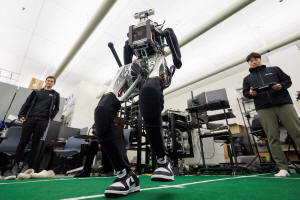|
Using cutting edge technology, ARTEMIS, which stands for
Advanced Robotic Technology for Enhanced Mobility and Improved
Stability, can maintain its balance against heavy kicks and
shoves, withstand objects being thrown at it and is capable of
running. But what sets ARTEMIS apart on top of that is its
ability to kick a ball.
"If your robot cannot even play a game of soccer, how would you
be able to use these robots for more important things, such as
saving people's lives?" said Dennis Hong, professor of
mechanical and aerospace engineering and director of the
Robotics and Mechanisms Laboratory (RoMeLa) at UCLA, which
developed ARTEMIS.
The technologies used for soccer playing robots are also being
used for other applications like firefighting and disaster
relief, said Hong.
While ARTEMIS may not be at the next FIFA World Cup, Hong's team
will be unveiling its full soccer capabilities at RoboCup in
Bordeaux, France, in July.
The robot’s major innovation is that the engineers
custom-designed its actuators — devices that generate motion
from energy — to behave like biological muscles. They are
springy and force-controlled, rather than the rigid,
position-controlled actuators that most robots have.
ARTEMIS’ actuators are also unique in that they are electrically
driven, rather than controlled by hydraulics. That means it is
quieter and operates more efficiently, while also being cleaner,
because hydraulic systems are notorious for leaking fluids.
RoMeLa student Justin Quan said his personal goal is engineering
robots that improve people's lives.
"Seeing these robots helping push the robot technology to that
next level is really rewarding because you're like, oh, the
dream, it gets closer," he said.
(Reporting by Jorge Garcia and Alan Devall; Writing by Josie
Kao; Editing by Sonali Paul)
[© 2023 Thomson Reuters. All rights
reserved.] Copyright 2022 Reuters. All rights reserved. This material may not be published,
broadcast, rewritten or redistributed.
Thompson Reuters is solely responsible for this content.

|
|



